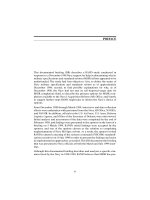International Law and International Relations docx
Bạn đang xem bản rút gọn của tài liệu. Xem và tải ngay bản đầy đủ của tài liệu tại đây (3.4 MB, 777 trang )
This page intentionally left blank
International Law and International Relations
This volume is intended to help readers understand the relationship
between international law and international relations (IL/IR). As a testa-
ment to this dynamic area of inquiry, new research on IL/IR is now being
published in a growing list of traditional law reviews and disciplinary
journals. The excerpted articles in this volume, all of which were first
published in International Organization, represent some of the most
important research since serious social science scholarship began in
this area more than twenty years ago. They are important milestones
toward making IL/IR a central concern of scholarly research in
international affairs. The contributions have been selected to cover
some of the main topics of international affairs and to provide readers
with a range of theoretical perspectives, concepts, and heuristics that
can be used to analyze the relationship between international law and
international relations.
Beth A. Simmons is Professor of Government and Director of the
Weatherhead Center for International Affairs at Harvard University,
Cambridge, Massachusetts.
Richard H. Steinberg is Professor of Law at the University of California,
Los Angeles, and Senior Scholar in the Division of International,
Comparative and Area Studies at Stanford University, Stanford,
California.
International Organization Books
Issues and Agents in International Political Economy, edited by
Benjamin J. Cohen and Charles Lipson
Theory and Structure in International Political Economy, edited by
Charles Lipson and Benjamin J. Cohen
International Institutions, edited by Lisa L. Martin and Beth A. Simmons
International Institutions and Socialization in Europe, edited by Jeffrey
T. Checkel
International Law and International Relations, edited by Beth A. Simmons
and Richard H. Steinberg
International Law and International
Relations
Edited by
BETH A. SIMMONS and RICHARD H. STEINBERG
CAMBRIDGE UNIVERSITY PRESS
Cambridge, New York, Melbourne, Madrid, Cape Town, Singapore, São Paulo
Cambridge University Press
The Edinburgh Building, Cambridge CB2 8RU, UK
First published in print format
ISBN-13 978-0-521-86186-1
ISBN-13 978-0-521-67991-6
ISBN-13 978-0-511-29494-5
© 2006 IO Foundation
2007
Information on this title: www.cambridge.org/9780521861861
This publication is in copyright. Subject to statutory exception and to the provision of
relevant collective licensing agreements, no reproduction of any part may take place
without the written
p
ermission of Cambrid
g
e University Press.
ISBN-10 0-511-29494-8
ISBN-10 0-521-86186-1
ISBN-10 0-521-67991-5
Cambridge University Press has no responsibility for the persistence or accuracy of urls
for external or third-party internet websites referred to in this publication, and does not
g
uarantee that any content on such websites is, or will remain, accurate or a
pp
ro
p
riate.
Published in the United States of America by Cambridge University Press, New York
www.cambridge.org
hardback
paperback
paperback
eBook (EBL)
eBook (EBL)
hardback
Contents
Contributors page ix
Abstracts xiii
Preface xxix
Beth A. Simmons and Richard H. Steinberg
Editors’ Note xxxvii
part i. international regimes theory:
does law matter?
1 Structural Causes and Regime Consequences: Regimes
as Intervening Variables (1982) 3
Stephen D. Krasner
2 The Demand for International Regimes (1982) 18
Robert O. Keohane
part ii. commitment and compliance
3 Democratic States and Commitment in International
Relations (1996) 43
Kurt Taylor Gaubatz
4 On Compliance (1993) 65
Abram Chayes and Antonia Handler Chayes
5 Is the Good News About Compliance Good News About
Cooperation? (1996) 92
George W. Downs, David M. Rocke, and Peter N. Barsoom
v
part iii. legalization and its limits
6 The Concept of Legalization (2000) 115
Kenneth W. Abbot, Robert O. Keohane, Andrew Moravcsik,
Anne-Marie Slaughter, and Duncan Snidal
7 Legalized Dispute Resolution: Interstate and Transnational
(2000) 131
Robert O. Keohane, Andrew Moravcsik, and Anne-Marie Slaughter
8 Legalization, Trade Liberalization, and Domestic Politics:
A Cautionary Note (2000) 157
Judith Goldstein and Lisa L. Martin
9 Alternatives to ‘‘Legalization’’: Richer Views of Law
and Politics (2001) 188
Martha Finnemore and Stephen J. Toope
part iv. international law and international norms
10 Quasi-States, Dual Regimes, and Neoclassical Theory:
International Jurisprudence and the Third World
(1987) 205
Robert H. Jackson
11 Which Norms Matter? Revisiting the ‘‘Failure’’ of
Internationalism (1997) 233
Jeffrey W. Legro
12 The Territorial Integrity Norm: International Boundaries
and the Use of Force (2001) 259
Mark W. Zacher
part v. treaty design and dynamics
13 Why Are Some International Agreements Informal? (1991) 293
Charles Lipson
14 The Politics of Dispute Settlement Design: Explaining
Legalism in Regional Trade Pacts (2000) 331
James McCall Smith
15 Loosening the Ties that Bind: A Learning Model
of Agreement Flexibility (2001) 375
Barbara Koremenos
16 Driving with the Rearview Mirror: On the Rational Science
of Institutional Design (2001) 403
Alexander Wendt
vi
Contents
17 The Dynamics of International Law: The Interaction
of Normative and Operating Systems (2003) 426
Paul F. Diehl, Charlotte Ku, and Daniel Zamora
part vi. law and legal institutions
18 Europe Before the Court: A Political Theory of Legal
Integration (1993) 457
Anne-Marie Slaughter [Burley] and Walter Mattli
19 The European Court of Justice, National Governments,
and Legal Integration in the European Union (1998) 486
Geoffrey Garrett, R. Daniel Kelemen, and Heiner Schulz
part vii. other substantive areas of international law
Security
20 Scraps of Paper? Agreements and the Durability
of Peace (2003) 515
Virginia Page Fortna
Trade
21 In the Shadow of Law or Power? Consensus-Ba sed
Bargaining and Outcomes in the GATT/WTO (2002) 543
Richard H. Steinberg
Money
22 The Legalization of International Monetary Affairs (2000) 568
Beth A. Simmons
War Crimes
23 Constructing an Atrocities Regime: The Politics of War
Crimes Tribunals (2001) 594
Christopher Rudolph
Human Rights
24 The Origins of Human Rights Regimes: Democratic
Delegation in Postwar Europe (2000) 622
Andrew Moravcsik
Environment
25 Regime Design Matters: Intentional Oil Pollution
and Treaty Compliance (1994) 653
Ronald B. Mitchell
Contents vii
Intellectual Property
26 The Regime Complex for Plant Genetic Resources (2004) 684
Kal Raustiala and David G. Victor
References 711
Index 713
viii Contents
Contributors
Volume Editors
Beth A. Simmons is Professor of Government and Director of the
Weatherhead Center for International Affairs at Harvard University,
Cambridge, Massachusetts.
Richard H. Steinberg is Professor of Law at the University of California,
Los Angeles, and Senior Scholar in the Division of International,
Comparative and Area Studies at Stanford University, Stanford,
California.
Contributors
Kenneth W. Abbot is Professor of Law at Arizona State University,
Tempe, Arizona.
Peter N. Barsoom is Director of Credit Card Services at Merrill Lynch,
New York, New York.
Abram Chayes (1922–2000) was Professor of Law at Harvard Univer-
sity, Cambridge, Massachusetts.
Antonia Handler Chayes is Adjunct Lecturer in Public Policy at the John
F. Kennedy School of Government at Harvard University, Cambridge,
Massachusetts.
Paul F. Diehl is Professor of Political Science at the University of Illinois
at Urbana-Champaign.
ix
George W. Downs is Professor of Politics at New York University,
New York, New York.
Martha Finnemore is Professor of Political Science and International
Affairs at George Washington University, Washington, D.C.
Virginia Page Fortna is Assistant Professor of Political Science at
Columbia University, New York, New York.
Geoffrey Garrett is Professor of International Relations at University of
Southern California, Los Angeles, and President of the Pacific Council
on International Policy, Los Angeles, California.
Kurt Taylor Gaubatz is Associate Professor of International Studies at
Old Dominion University, Norfolk, Virginia.
Judith Goldstein is Professor of Political Science, Sakurako and William
Fisher Family Director of International, Comparative and Area Studies,
and The Kaye University Fellow in Undergraduate Education at Stanford
University, Stanford, California.
Robert H. Jackson is Professor of International Relations and Political
Science at Boston University, Boston, Massa chusetts.
R. Daniel Kelemen is University Lecturer and Tutorial Fellow at Lincoln
College, University of Oxford.
Robert O. Keohane is Professor of International Affairs at Princeton
University, Princeton, New Jersey.
Barbara Koremenos is Assistant Professor of Political Science at the Uni-
versity of Michigan, Ann Arbor.
Stephen D. Krasner is Director of Policy Planning at the United States De-
partment of State, Washington, D.C., and Professor of Political Science
at Stanford University, Stanford, California.
Charlotte Ku is Executive Vice President and Executive Director of the
American Society of International Law, Washington, D.C.
Jeffrey W. Legro is Associate Professor of International Relations at the
University of Virginia, Charlottesville, Virginia.
Charles Lipson is Professor of Political Science at the University of
Chicago, Chicago, Illinois.
x Contributors
Lisa L. Martin is Professor of Government and a member of the Execu-
tive Committee of The Weatherhead Center for International Affairs at
Harvard University, Cambridge, Massachusetts.
Walter Mattli is the Fellow in Politics at St. John’s College and Profes-
sor of International Political Economy, Oxford University, Oxford,
England.
Ronald B. Mitchell is Professor of Political Science at the University of
Oregon, Eugene, Oregon.
Andrew Moravcsik is Professor of Politics at Princeton University,
Princeton, New Jersey.
Kal Raustiala is Professor of Law and Glo bal Studies at the University of
California, Los Angeles.
David M. Rocke is Professor of Biostatistics, Professor of Applied
Science, and Co-Director of the Institute for Data Analysis and Visual-
ization at the University of California, Davis.
Christopher Rudolph is Professor of International Politics at American
University, Washing ton, D.C.
Heiner Schulz is Assistant Professor of Political Science at University of
Pennsylvania, Philadelphia, Pennsylvania.
Anne-Marie Slaughter [Burley] is Dean of the Woodrow Wilson School
of Public and International Affairs at Princeton University, Princeton,
New Jersey.
James McCall Smith is Assistant Professor of Political Science and
International Affairs at George Washington University, Washington, D.C.
Duncan Snidal is Associate Professor of Political Science and a mem-
ber of the Committee on International Relations at the University of
Chicago, Chicago, Illinois.
Stephen J. Toope is Professor of Law at McGill University, Quebec,
Canada.
David G. Victor is Associate Professor of Political Science at Stanford
University and director of the Program on Energy and Sustainable De-
velopment at the Center for Environmental Science and Policy, Stanford,
California.
Contributors
xi
Alexander Wendt is the Ralph D. Mershon Professor of International
Security and the Mersho n Center Professor of Political S cience at Ohio
State University, Columbus, Ohio.
Mark W. Zacher is Professor Emeritus of Political Science, Senior
Research Fellow at the Centre of International Relations, and Faculty
Fellow, St. John’s College, University of British Columbia, Vancouver,
Canada.
Daniel Zamora is an associate at the law firm of Tobin & Tobin, San
Francisco, California.
xii Contributors
Abstracts
Structural Causes and Regime Consequences: Regimes as Intervening
Variables (1982)
by Stephen D. Krasner
International regimes are defined as principles, norms, rules, and decision-
making procedures around which actor expectations converge in a given
issue-area. As a starting point, regimes have been conceptualized as
intervening variables, standing between basic causal factors and related
outcomes and behavior. There are three views about the importance of
regimes: conventional structural orientations dismiss regimes as being at
best ineffectual; Grotian orientations view regimes as an intimate com-
ponent of the international system; and modified structural perspectives
see regimes as significant only under certain constrained conditions. For
Grotian and modified structuralist arguments, which endorse the view
that regimes can influence outcomes and behavior, regime development is
seen as a function of five basic causal variables: egoistic self-interest,
political power, diffuse norms and principles, custom and usage, and
knowledge.
The Demand for International Regimes (1982)
by Robert O. Keohane
International regimes can be understood as results of rational behavior by
the actors – principally states – that create them. Regimes are demanded
in part because they facilitate the making of agreements, by providing
information and reducing transaction costs in world politics. Increased
xiii
interdependence among issues – greater ‘‘issue density’’ – will lead to
increased demand for regimes. Insofar as regimes succeed in providing
high-quality information, through such processes as the construction of
generally accepted norms or the development of transgovernmental rel a-
tions, they create demand for their own continuance, even if the structural
conditions (such as hegemony) under which they were first supplied
change. Analysis of the demand for international regimes thus helps
us to understand lags between structural change and regime change, as
well as to assess the significance of transgovernm ental policy networks.
Several assertions of structural theory seem problematic in light of this
analysis. Hegemony may not be a necessary condition for stable in-
ternational regimes; past patterns of institutionalized cooperation may
be able to compensate, to some extent, for increasing fragmentation of
power.
Democratic States and Commitment in International Relations
(1996)
by Kurt Taylor Gaubatz
Making credible commitments is a formidable problem for states in
the anarchic international system. A long-standing view holds that this
is particularly true for democratic states in which changeable public pre-
ferences make it difficult for leaders to sustain commitments over
time. However, a number of important elements in the values and insti-
tutions that have characterized the liberal democratic states should en-
hance their ability to sustain international commitments. Indeed, an
examination of the durability of international military alliances confirms
that those between democratic states have endured longer than either
alliances between nondemocracies or alliances between democracies and
nondemocracies.
On Com pliance (1993)
by Abram Chayes and Antonia Handler Chayes
A new dialogue is beginning between students of intern ational law and
international relations scholars concerning compliance with interna-
tional agreements. This article advances some basic propositions to frame
that dialogue. First, it proposes that the level of compliance with inter-
national agreements in general is inherently unverifiable by empirical
procedures. That nations generally comply with their international
xiv Abstracts
agreements, on the one hand, or that they violate them whenever it is in
their interest to do so, on the other, are not statements of fact or even hy-
potheses to be tested. Instead, they are competing heuristic assumptions.
Some reasons why the background assumption of a propensity to comply
is plausible and useful are given. Second, compliance problems very often
do not reflect a deliberate decision to violate an international undertaking
on the basis of a calculation of advantage. The article proposes a variety of
other reasons why states may deviate from treaty obligations and why in
many circumstances those reasons are properly accepted by others as
justifying apparent departures from treaty norms. Third, the treaty regime
as a whole need not and should not be held to a standard of strict com-
pliance but to a level of overall compliance that is ‘‘acceptable’’ in the
light of the interests and concerns the treaty is designed to safeguard.
How the acceptable level is determined and adjusted is considered.
Is the Good News About Compliance Good News About
Cooperation? (1996)
by George W. Downs, David M. Rocke, and Peter N. Barsoom
Recent research on compliance in international regulatory regimes has
argued (1) that compliance is generally quite good; (2) that this high level
of compliance has been achieved with little attention to enforcement;
(3) that those compliance problems that do exist are best addressed as
management rather than enforcement problems; and (4) that the manage-
ment rather than the enforcement approach holds the key to the evolution
of future regulatory cooperation in the international system. While the
descriptive findings are largely correct, the policy inferences are dan-
gerously contaminated by endo geneity and selection problems. A high
rate of compliance is often the result of states formulating treaties that
require them to do little more than they would do in the a bsence of a
treaty. In those cases where noncompliance does occur and where the
effects of selection are attenuated, both self-interest and enforcement play
significant roles.
The Concept of Legalization (2000)
by Kenneth W. Abbot, Robert O. Keohane, Andrew Moravcsik,
Anne-Marie Slaughter, and Duncan Snidal
We develop an empirically based conception of international legalization
to show how law and politics are intertwined across a wide range of
Abstracts
xv
institutional forms and to frame the analytic and empirical articles that
follow in this volume. International legalization is a form of institution-
alization characterized by three dimensions: obligation, precision, and
delegation. Obligation means that states are legally bound by rules or com-
mitments and are therefore subject to the general rules and procedures of
international law. Precision means that the rules are definite, unambigu-
ously defining the conduct they require, authorize, or proscribe. Delega-
tion grants authority to third parties for the implementation of rules,
including their interpretation and application, dispute settlement, and
(possibly) further rule making. These dimensions are conceptually in-
dependent, and each is a matter of degree and gradation. Their various
combinations produce a remarkable variety of international legalization.
We illustrate a continuum ranging from ‘‘hard’’ legalization (characteris-
tically associated with domes tic legal systems) through various forms of
‘‘soft’’ legalization to situations where law is largely absent. Most in-
ternational legalization lies between the extremes, where actors combine
and invoke varying degrees of obligation, precision, and delegation to
create subtle blends of politics and law.
Legalized Dispute Resolution: Interstate and Transnational
(2000)
by Robert O. Keohane, Andrew Moravcsik, and
Anne-Marie Slaughter
We identify two ideal types of international third-party dispute resolu-
tion: interstate and transnational. Under interstate dispute resolution,
states closely control selection of, access to, and compliance with in-
ternational courts and tribunals. Under transnational dispute resolution,
by contrast, individuals and nongovernmental entities have significant
influence over selection, access, and implementation. This distinction
helps to explain the politics of international legalization – in particular,
the initiation of cases, the tendency of courts to challenge national gov-
ernments, the extent of compliance with judgments, and the long-term
evolution of norms withi n legalized international regimes. By reducing the
transaction costs of setting the process in motion and establishing new
constituencies, transnational dispute resolution is more likely than inter-
state dispute resolution to generate a large number of cases. The types of
cases brought under transnational dispute resolution lead more readily
to challenges of state actions by international courts. Transnational dis-
pute resolution tends to be associated with greater compliance with
xvi Abstracts
international legal judgments, particularly when autonomous domestic
institutions such as the judiciary mediate between individuals and the
international institutions. Over all, transnational dispute resolution en-
hances the prospects for long-term deepening and widening of interna-
tional legalization.
Legalization, Trade Liberalization, and Domestic Politics:
A Cautionary Note (2000)
by Judith Goldstein and Lisa L. Martin
If the purpose of legalization is to enhance international cooperation,
more may not always be better. Achieving the optimal level of legaliza-
tion requires finding a balance between reducing the risks of opportunism
and reducing the potential negative effects of legalization on domestic
political processes. The global trade regime, which aims to liberalize
trade, has become increasingly legalized over time. Increased legaliza-
tion has changed the information environment and the nature of govern-
ment obligations, which in turn have affected the pattern of mobilization
of domestic interest groups on trade . From the perspective of encourag-
ing the future expansion of liberal trade, we suggest some possible nega-
tive consequences of legalization, arguing that these consequences must
be weighed against the positive effects of legalization on increasing
national compliance. Since the weakly legalized GATT institution proved
sufficient to su stain widespread liberalization, the case for further legal-
ization must be strong to justify far-reaching change in the global trade
regime.
Alternatives to ‘‘Legalization’’: Richer Views of Law and Politics (2001)
by Martha Finn emore and Stephen J. Toope
The authors of ‘‘Legalization and World Politics’’ (International Organi-
zation, 54, 3, summer 2000) define ‘‘legalization’’ as the degree of obliga-
tion, precision, and delegation that international institutions possess.
We argue that this definition is unnecessarily narrow. Law is a broad
social phenomenon that is deeply embedded in the practices, beliefs, and
traditions of societies. Understanding its role in politics requires attention
to the legitimacy of law, to custom and law’s congruence with social
practice, to the role of legal rationality, and to adherence to legal pro-
cesses, including participation in law’s construction. We examine three
applications of ‘‘legalization’’ offered in the volume and show how a fuller
Abstracts
xvii
consideration of law’s role in politics can produce concepts that are more
robust intellectually and more helpful to empirical research.
Quasi-States, Dual Regimes, and Neoclassical Theory: International
Jurisprudence and the Third World (1987)
by Robert H. Jackson
Decolonization in parts of the Third World and particularly Africa has
resulted in the emergence of numerous ‘‘quasi-states,’’ which are in-
dependent largely by international courtesy. They exist by virtue of an
external right of self-determination – negative sovereignty – without yet
demonstrating much internal capacity for effective and civil government –
positive sovereignty. They therefore disclose a new dual international
civil regime in which two standards of statehood now coexist: the tradi-
tional empirical standard of the North and a new juridical standard of the
South. The biases in the constitutive rules of the sovereignty game today
and for the first time in moder n international history arguably favor the
weak. If international theory is to account for this novel situation, it must
acknowledge the possibility that morality and legality can, in certain
circumstances, be independent of power in international relations. This
suggests that contemporary international theory must accommodate not
only Machiavellian realism and the sociological discourse of power but
also Grotian rationalism and the jurisprudential idiom of law.
Which Norms Matter? Revisiting the ‘‘Failure’’ of
Internationalism (1997)
by Jeffrey W. Legro
Scholars tend to believe either that norms are relatively inconsequential or
that they are powerful determinants of international politics. Yet the
former view overlooks important effects that norms can have, while the
latter inadequately specifies which norms matter, the ways in which
the norms have an impact, and the magnitude of norm influence relative
to other factors. Three different norms on the use of force from the
interwar period vari ed in their influence during World War II. The vari-
ation in state adherence to these norms is best explained by the cultures
of national military organizations that mediated the influence of the
international rules. This analysis highlights the challenge and importance
of examining the relative effects of the often cross-cutting prescriptions
imbedded in different types of social collectivities.
xviii Abstracts
The Territorial Integrity Norm: International Boundaries and the Use
of Force (2001)
by Mark W. Zacher
Scholars and observers of the international system often comment on the
decreasing importance of international boundaries as a result of the
growth of international economic and social exchanges, economic liber-
alization, and international regimes. They generally fail to note, however,
that coercive territorial revisionism has markedly declined over the past
half century – a phenomenon that indicates that in certain ways states at-
tach greater importance to boundaries in our present era. In this article
I first trace states’ beliefs an d practices concerning the use of force to alter
boundaries from the birth of the Westphalian order in the seventeenth
century through the end of World War II. I then focus on the increasing
acceptance of the norm against coercive territorial revisionism since 1945.
Finally, I analyze those instrumental and ideational factors that have in-
fluenced the strengthening of the norm among both Western and de-
veloping countries.
Why Are Some International Agreements Informal? (1991)
by Charles Lipson
Informal agreements are the most common form of international co-
operation and the least studied. Ranging from simple oral deals to de-
tailed executive agreements, they permit states to conclude profitable
bargains without the formality of treaties. They differ from treaties in more
than just a procedural sense. Treaties are designed, by long-standing
convention, to raise the credibility of promises by staking national
reputation on their adherence. Informal agreements have a more ambig-
uous status and are useful for precisely that reason. They are chosen to
avoid formal and visible national pledges, to avoid the political obstacles
of ratification, to reach agreements quickly and quietly, and to provide
flexibility for subsequent modification or even renunciation. They differ
from formal agreements not because their substance is less important (the
Cuban missile crisis was solved by informal agreement) but because the
underlying promises are less visible and more equivocal. The prevalence of
such informal devices thus reveals not only the possibilities of international
cooperation but also the practical obstacles and the institutional limits to
endogenous enforcement.
Abstracts
xix
The Politics of Dispute Settlement Design: Explaining Legalism
in Reg ional Trade Pacts (2000)
by James McCall Smith
Dispute settlement mechanisms in international trade vary dramati-
cally from one agreement to another. Some mechanisms are highly legal-
istic, with standing tribunals that resemble national courts in their
powers and procedures. Others are diplomatic, requiring only that the
disputing countries make a good-faith effort to resolve their differ-
ences through consultations. In this article I seek to account for the
tremendous variation in institutional design across a set of more than
sixty post-1957 regional trade pacts. In contrast to accounts that em-
phasize the transaction costs of collective action or the functional re-
quirements of deep integration, I find that the level of legalism in each
agreement is strongly related to the level of economic asymmetry, in
interaction with the proposed depth of liberalization, among member
countries.
Loosening the Ties that Bind: A Learning Model of Agreement
Flexibility (2001)
by Barbara Koremenos
How can states credibly make and keep agreements when they are
uncertain about the distributional implications of their cooperation? They
can do so by incorporating the proper degree of flexibility into their agree-
ments. I develop a formal model in which an agreement characterized
by uncertainty may be renegotiated to incorporate new information. The
uncertainty is related to the division of gains under the agreement, with
the parties resolving this uncertainty over time as they gain experien ce with
the agreement. The greater the agreement uncertainty, the more likely
states will want to limit the duration of the agreement and incorporate
renegotiation. Working against renegotiation is noise – that is, variation in
outcomes not resulting from the agreement. The greater the noise, the more
difficult it is to learn how an agreement is actually working; hence,
incorporating limited duration and renegotiation provisions becomes less
valuable. In a detailed case study, I demonstrate that the form of un-
certainty in my model corresponds to that experienced by the parties to
the Nuclear Non-proliferation Treaty, who adopted the solution my
model predicts.
xx Abstracts
Driving with the Rearview Mirror: On the Rational Science
of Institutional Design (2001)
by Alexander Wendt
The Rational Design project is impressive on its own terms. However, it
does not address other approaches relevant to the design of interna-
tional institutions. To facilitate comparison I survey two ‘‘contrast spaces’’
around it. The first shares the project’s central question – What explains
institutional design? – but addresses alternative explanations of two types:
rival explanations and explanations complementary but deeper in the
causal chain. The second contrast begins with a different question: What
kind of knowledge is needed to design institutions in the real world?
Asking this question reveals epistemological differences between positive
social science and institutional design that can be traced to different
orientations toward time. Making institutions is about the future and has
an intrinsic normative element. Explaining institutions is about the past
and does not necessarily have this normative dimension. To avoid ‘‘driving
with the rearview mirror’’ we need two additional kinds of knowledge
beyond that developed in this volume: knowledge about institutional
effectiveness and knowledge about what values to pursue. As such, the
problem of institutional design is a fruitful site for developing a broader
and more practical conception of social science that integrates normative
and positive concerns.
The Dynamics of International Law: The Interaction of Normative
and Operating Systems (2003)
by Paul F. Diehl, Charlotte Ku, and Daniel Zamora
This article describes the basic components of the operating and normative
systems as a conceptual framework for analyzing and understanding
international law. There are many theoretical questions that follow from
the framework that embodies a normative and operating system. We
briefly outline one of those in this article, namely how the operating sys-
tem changes. In doing so, we seek to address the puzzle of why operating
system changes do not always respond to alterations in the normative
sphere. A general theoretical argument focuses on four conditions. We
argue that the operating system only responds to normative changes when
response is ‘‘necessary’’ (stemming from incompatibility, ineffectiveness,
or insufficiency) for giving the norm eff ect and when the chan ge is roughly
coterminous with a dramatic change in the political environment (that is,
Abstracts
xxi
‘‘political shock’’). We also argue, however, that opposition from leading
states and domestic political factors might serve to block or limit such
operating system change. These arguments are illustrated by reference to
three areas of the operating system as they concern the norm against
genocide.
Europe Before the Court: A Political Theory of Legal
Integration (1993)
by Anne-Marie Slaughter [Burley] and Walter Mattli
The European Court of Justice has been the dark horse of European
integration, quietly transforming the Treaty of Rome into a European
Community (EC) constitution and steadily increasing the impact and
scope of EC law. While legal schol ars have tended to take the Court’s
power for granted, political scientists have overlooked it entirely. This
article develops a first-stage theory of community law and politics that
marries the insights of legal scholars with a theoretical framework
developed by political scientists. Neofunctionalism, the theory that
dominated regional integration studies in the 1960s, offers a set of
independent variables that convincingly and parsimoniously explain the
process of legal integration in the EC. Just as neofunctionalism predicts,
the principal forces behind that process are supranational and subnational
actors pursuing their own self-interests within a politically insulate d
sphere. Its distinctive features include a widening of the ambit of successive
legal decisions according to a functional logic, a gradual shift in the
expectations of both government institutions and private actors partici-
pating in the legal system, and the strategic subordination of immediate
individual interests of member states to postulated collective interests over
the long term. Law functions as a mask for politics, precisely the role
neofunctionalists originally forecast for economics. Paradoxically, how-
ever, the success of legal institutions in performing that function rests on
their self-conscious preservation of the autonomy of law.
The European Court of Justice, National Governments, and Legal
Integration in the European Union (1998)
by Geoffrey Garrett, R. Daniel Kelemen, and Heiner Schulz
We develop a game theoretic model of the conditions under which the
European Court of Justice can be expected to take ‘‘adverse judgments’’
xxii Abstracts
against Euro pean Union member governments and when the govern-
ments are likely to abide by these decisions. The model generates three hy-
potheses. First, the greater the clarity of EU case law precedent, the lesser
the likelihood that the Court will tailor its decisions to the anticipated
reactions of member governments. Second, the greater the domestic costs
of an ECJ ruling to a litigant government, the lesser the likelihood that
the litigant government will abide by it (and hence the lesser the likelihood
that the Court will make such a ruling). Third, the greater the activism
of the ECJ and the larger the number of member governments adversely
affected by it, the greater the likelihood that responses by litigant govern-
ments will move from individual nonco mpliance to coordinated retalia-
tion through new legislation or treaty revisions. These hypotheses are
tested against three broad lines of case law central to ECJ jurisprudence:
bans on agricultural imports, application of principles of equal treatment
of the sexes to occupational pensions, and state liability for violation of
EU law. The empirical analysis supports our view that though influenced
by legal precedent, the ECJ also takes into account the anticipa ted re-
actions of member governments.
Scraps of Paper? Agreements and the Durability
of Peace (2003)
by Virginia Page Fortna
In the aftermath of war, what determines whether peace lasts or fight-
ing resumes, and what can be done to foster durable peace? Drawing on
theories of cooperation, I argue that belligerents can overcome the
obstacles to peace by implementing measures that alter incentives,
reduce uncertainty about intentions, and manage accidents. A counterar-
gument suggests that agreements are epiphenomenal, merely reflecting
the underlying probability of war resumption. I test hypotheses about
the durabili ty of peace using hazard analysis. Controlling for factors
(including the decisiveness of victory, the cost of war, relative capabili-
ties, and others) that affect the baseline prospects for peace, I find that
stronger agreements enhance the durability of peace. In particular,
measures such as the creation of demilitarized zones, explicit third-party
guarantees, peacekeeping, and joint commissions for dispute resolu-
tion affect the duration of peace. Agreements are not merely scraps
of paper; rather, their content matters in the construction of peace that
lasts.
Abstracts
xxiii









